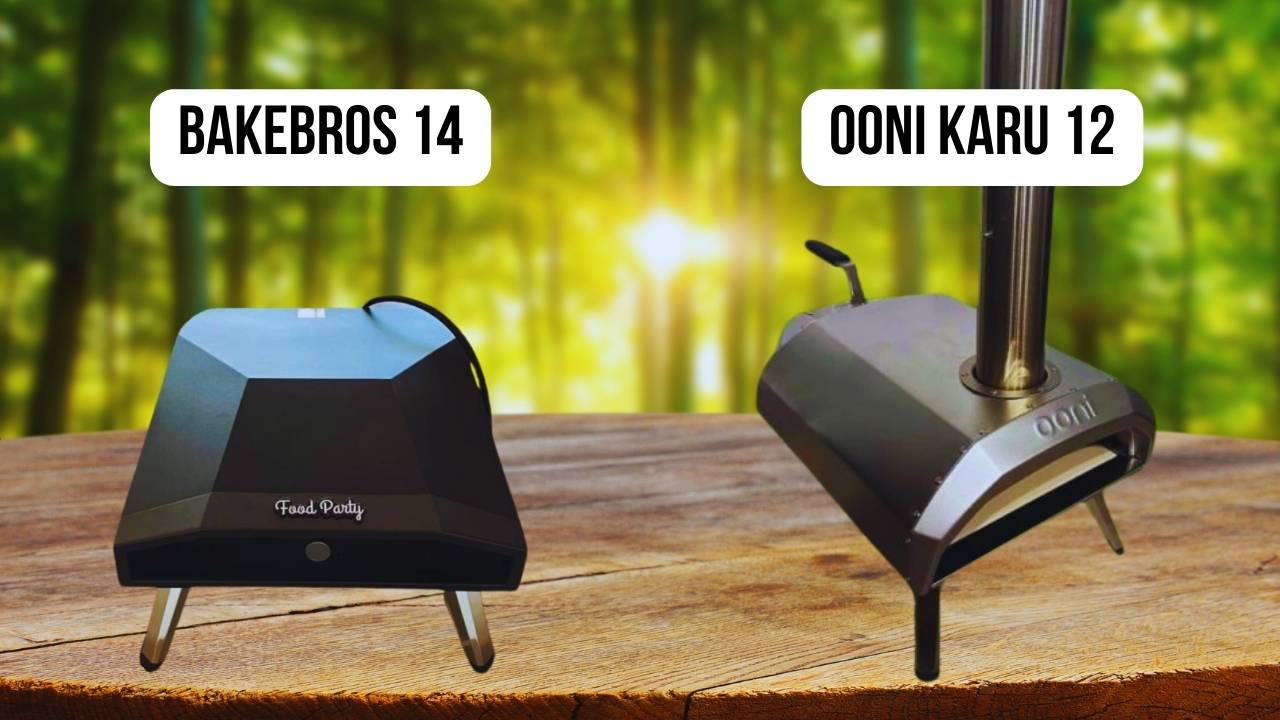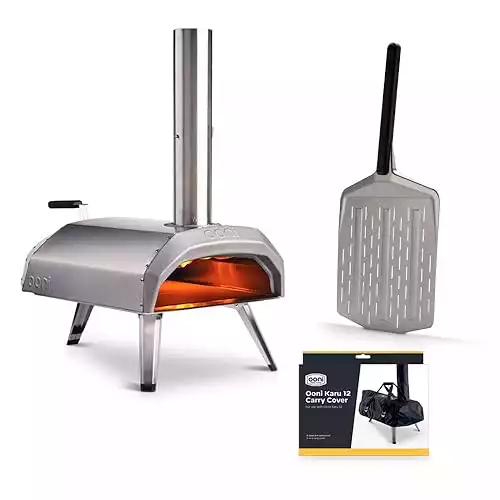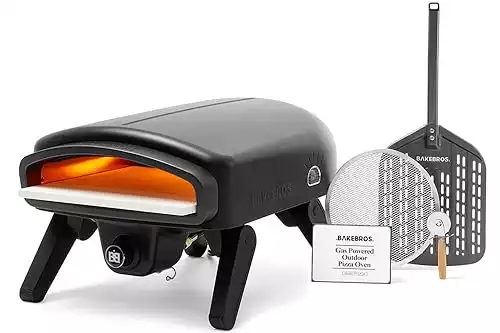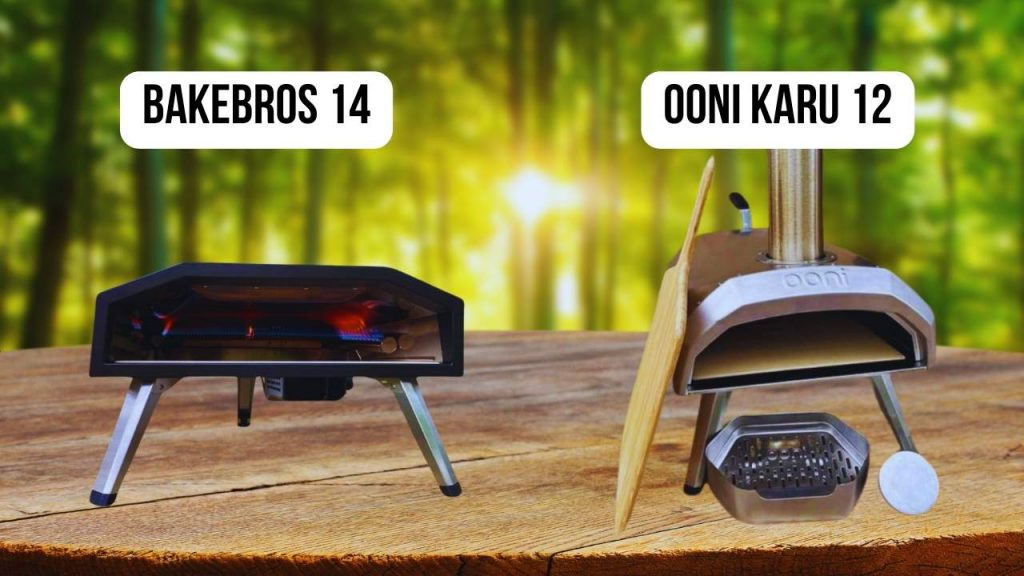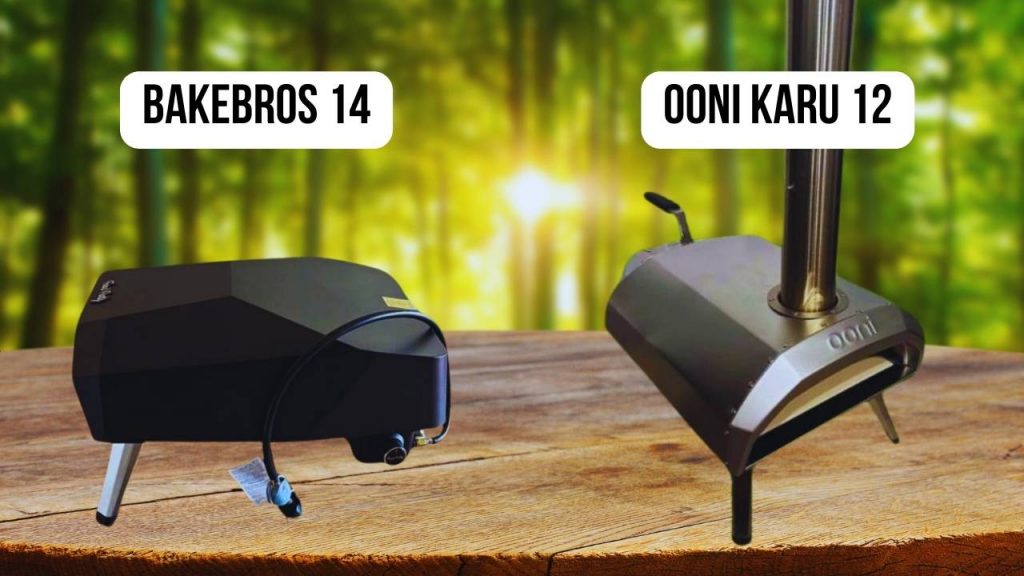As a restaurant chef with over 10 years of experience at Dequte Restaurant LironBoylston, I’ve had the opportunity to test a wide range of pizza ovens. In this comparison, I’ll share my insights on the Ooni Karu 12 and the Bakebros 14 Pizza Oven, both of which I’ve used extensively in my kitchen. My evaluation covers key factors such as quality and materials, temperature control, shape, first-time usage impressions, power source, size, ease of cleaning, and a real pizza cooking test to see how each performs. For a deeper dive into my testing methods, check out my separate article on how I test pizza ovens.
The Ooni Karu 12 is a versatile, portable oven known for its robust build and multiple fuel options. In contrast, the Bakebros 14 Pizza Oven is designed with simplicity and efficiency in mind, offering a user-friendly setup and larger cooking surface.
I’ve compared the Ooni Karu 12 and the Bakebros 14 in detail in this article, using my own test results.
These two pizza ovens didn’t make the TOP-5 pizza ovens, but they’re still great choices.
|
Our Rating:
4.3
|
Our Rating:
2.8
|
|
Pros:
|
Pros:
|
|
Cons:
|
Cons:
|
- High-quality construction with a durable stainless steel exterior
- Versatile, capable of reaching 900°F in 15-20 minutes
- Compact dome shape
- Multi-fuel
- Lighter
- Cleaning the Karu 12 requires regular ash removal when using wood
- The wood-fired setup has a learning curve
- Constructed from stainless steel
- Practical design
- Smaller and lighter (39.5 pounds), making it highly portable
- Struggles with consistent heat retention
- Requires a bit more practice to get used to
- Runs exclusively on LPG (propane gas)
- Requires more frequent maintenance due to less effective soot control
Lastly, please note that this article includes referral links, which help keep my blog alive. If you decide to purchase one of these ovens, I’d greatly appreciate your support!
Ooni Karu 12 VS Bakebros 14: Quality and Materials
| The Ooni Karu 12 features a robust stainless steel construction with exceptional durability and weather resistance, designed to withstand frequent use and high temperatures. |
The Bakebros 14 Pizza Oven is made of durable stainless steel, though it lacks the weight and premium feel of more robust models. The material is sufficient for casual use.
|
Ooni Karu 12 VS Bakebros 14: Temperature Control
| The Ooni Karu 12 offers versatile and precise temperature control, especially with its ability to use wood, charcoal, or gas. Heat retention is excellent, with even distribution for consistent results. |
The Bakebros 14 reaches up to 900°F and provides solid temperature control via LPG gas, though preheating takes longer, and maintaining consistent heat requires attention.
|
Ooni Karu 12 VS Bakebros 14: Shape
| The compact, dome-shaped design of the Ooni Karu 12 optimizes airflow and heat retention, ensuring an ideal environment for evenly cooked pizzas with a crispy crust. |
The Bakebros 14 has a compact, rectangular shape that promotes even cooking and portability, though its size makes crafting larger pizzas challenging.
|
Ooni Karu 12 VS Bakebros 14: First-Time Usage Impressions
| The Ooni Karu 12 impressed immediately with its sturdy build, quick heating, and ability to produce a perfect Margherita pizza with minimal effort. |
The Bakebros 14 had a slight learning curve but delivered impressive results once the nuances of heat and rotation were mastered.
|
Ooni Karu 12 VS Bakebros 14: Power Source
| The Ooni Karu 12 is highly versatile, offering wood, charcoal, or gas options (with a gas attachment sold separately), catering to various cooking preferences. |
The Bakebros 14 uses LPG gas, making it user-friendly and convenient, though it lacks the versatility of multiple fuel options.
|
Ooni Karu 12 VS Bakebros 14: Size
| Weighing 26 lbs (12 kg), the Ooni Karu 12 is portable and easy to transport, suitable for camping or outdoor cooking. |
The Bakebros 14, at 39.5 lbs and 24 x 17 x 14 inches, is compact and portable but slightly heavier, making it less convenient for frequent transport.
|
Ooni Karu 12 VS Bakebros 14: Ease of Cleaning
| The Ooni Karu 12 requires regular ash removal and chimney cleaning, with clear instructions to avoid water on internal components for longevity. |
The Bakebros 14 is straightforward to clean, with removable components like the stone and mesh disc for easy maintenance. Its smooth surfaces simplify the process.
|
Pizza Cooking Test
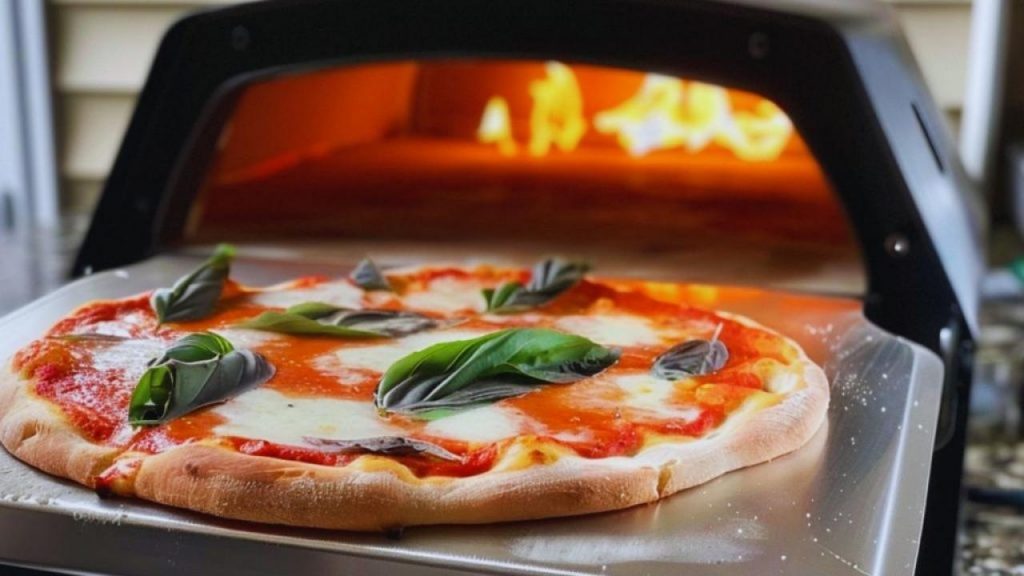
When it came to cooking pizzas, both the Ooni Karu 12 and the Bakebros 14 Pizza Oven showcased their capabilities, but there were notable differences in performance and results.
The Ooni Karu 12 heated up quickly, reaching its optimal cooking temperature of 715°F-850°F within 15-20 minutes. This efficiency was a standout feature, allowing us to get cooking faster. Once preheated, the oven cooked a classic Margherita pizza in under 2 minutes. The results were remarkable—an evenly cooked pizza with a golden, crispy crust, gooey melted cheese, and the subtle smokiness that only a wood-fired oven can provide. The balance of flavors and textures felt professional and effortless.
The Bakebros 14 Pizza Oven, while taking slightly longer to preheat at 20-30 minutes, also delivered high heat, reaching up to 900°F. It cooked a Margherita pizza in an impressive 60 seconds. However, achieving consistent results required careful monitoring and rotation of the pizza to avoid uneven cooking. The final pizza was delicious, with a crispy crust and well-cooked toppings, though some attempts showed minor inconsistencies due to heat distribution.
Overall, while both ovens produced flavorful pizzas, the Ooni Karu 12 stood out for its consistency and ease of use, delivering perfect results with less effort. The Bakebros 14 proved capable, especially for quick cooking, but required more attention to match the precision of the Ooni Karu 12. Both ovens offer great performance, but the Ooni Karu 12 shines as the more reliable choice for achieving professional-grade pizzas.
How We Tested
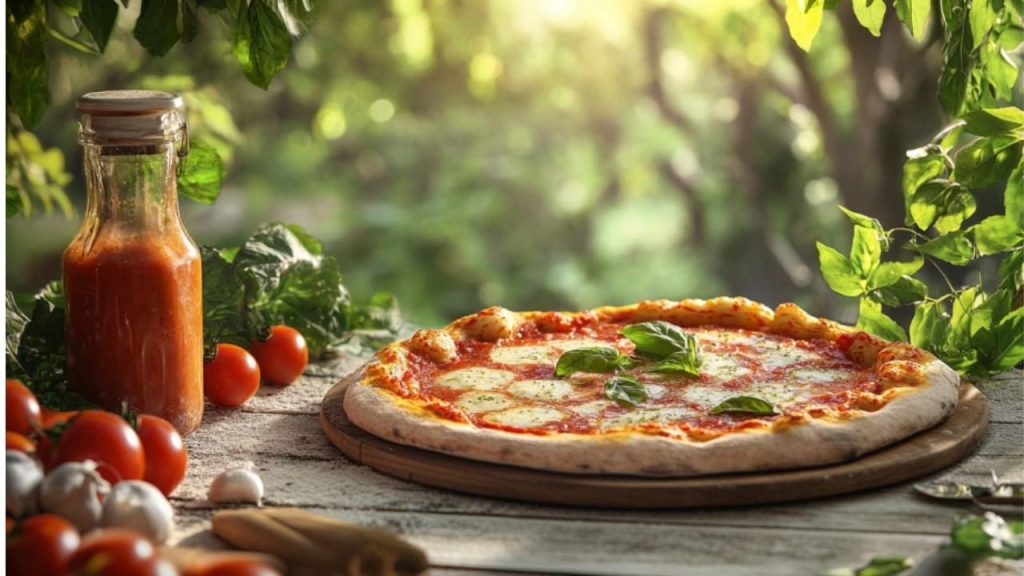
To ensure a fair and thorough comparison of the Ooni Karu 12 and the Bakebros 14 Pizza Oven, we conducted a series of tests designed to evaluate their real-world performance. Our testing process focused on critical factors that matter most to pizza enthusiasts and outdoor cooking fans.
First, we measured how long each oven took to preheat to its optimal cooking temperature. Using built-in thermometers and an infrared thermometer, we ensured precise readings of the internal chamber and pizza stone temperatures. This step was crucial to understanding each oven’s efficiency and heat retention capabilities.
Next, we cooked a classic Margherita pizza in both ovens. This timeless recipe allowed us to assess how evenly each oven cooked the crust, melted the cheese, and balanced the flavors. To maintain consistency, we used the same dough, sauce, and toppings for each test.
Cooking time was another key metric. We carefully timed how long it took for the pizzas to cook, ensuring both ovens operated within their recommended heat ranges. This helped us determine how quickly each oven could deliver a fully cooked pizza.
We also evaluated the taste and texture of the finished pizzas. Special attention was given to the crust’s crispiness, the cheese’s melt quality, and the overall flavor profile. We considered factors like the smoky notes from the wood-fired Ooni Karu 12 and the clean, consistent heat of the gas-powered Bakebros 14.
Ease of use was another critical aspect of our tests. We examined how straightforward each oven was to operate, including setting up the fuel, adjusting temperatures, and rotating the pizza during cooking. This provided insights into the learning curve and convenience of both models.
Finally, we explored each oven’s versatility by cooking additional dishes, such as flatbreads and roasted vegetables. This step highlighted their potential beyond pizza-making, showcasing how they performed with other types of food.
By applying the same rigorous methodology to both ovens, we ensured an unbiased evaluation that highlights their unique strengths and weaknesses. This comprehensive approach provided a clear picture of how the Ooni Karu 12 and the Bakebros 14 Pizza Oven perform in real-world scenarios, helping you make an informed choice.
Final Thoughts
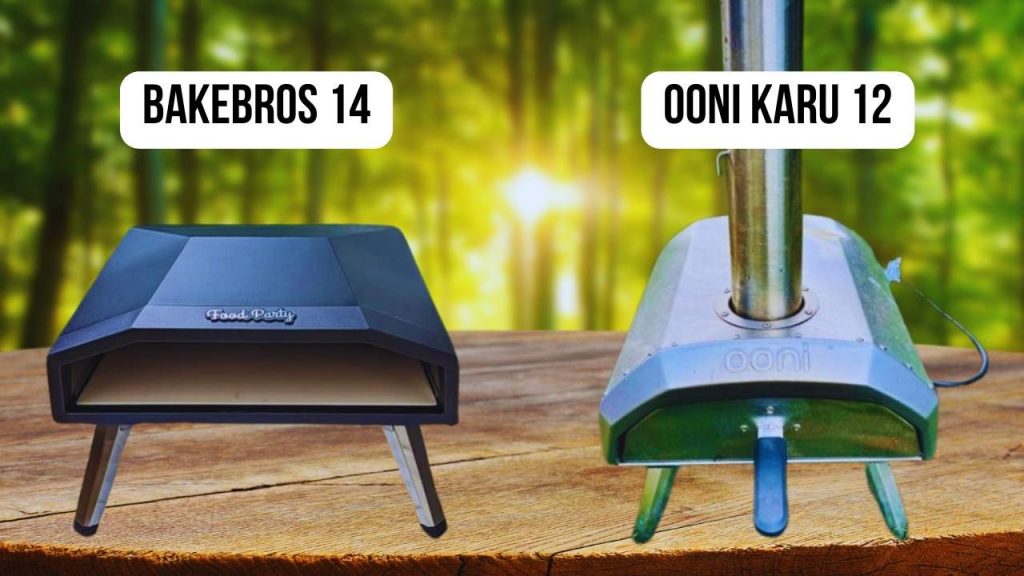
|
Our Rating:
4.3
|
Our Rating:
2.8
|
|
Pros:
|
Pros:
|
|
Cons:
|
Cons:
|
- High-quality construction with a durable stainless steel exterior
- Versatile, capable of reaching 900°F in 15-20 minutes
- Compact dome shape
- Multi-fuel
- Lighter
- Cleaning the Karu 12 requires regular ash removal when using wood
- The wood-fired setup has a learning curve
- Constructed from stainless steel
- Practical design
- Smaller and lighter (39.5 pounds), making it highly portable
- Struggles with consistent heat retention
- Requires a bit more practice to get used to
- Runs exclusively on LPG (propane gas)
- Requires more frequent maintenance due to less effective soot control
Both the Ooni Karu 12 and the Bakebros 14 Pizza Oven are excellent choices, each with unique strengths that cater to different preferences. The Ooni Karu 12 stands out for its premium build, versatility with multiple fuel options, and consistent, professional-grade results. On the other hand, the Bakebros 14 offers impressive high-temperature performance, a quick cooking time, and a more budget-friendly option for those seeking convenience in outdoor cooking.
Ultimately, the choice is yours based on your needs and priorities. Whether you prefer the versatility and craftsmanship of the Ooni Karu 12 or the straightforward efficiency of the Bakebros 14, both ovens can deliver fantastic pizzas.
If you decide to purchase one, I’d greatly appreciate it if you use my referral links. I’ll earn a small commission at no cost to you, which helps support my blog and allows me to continue sharing detailed reviews like this one.
Thank you for your support, and happy pizza-making!
Want a great pizza oven? Check out our top list.

